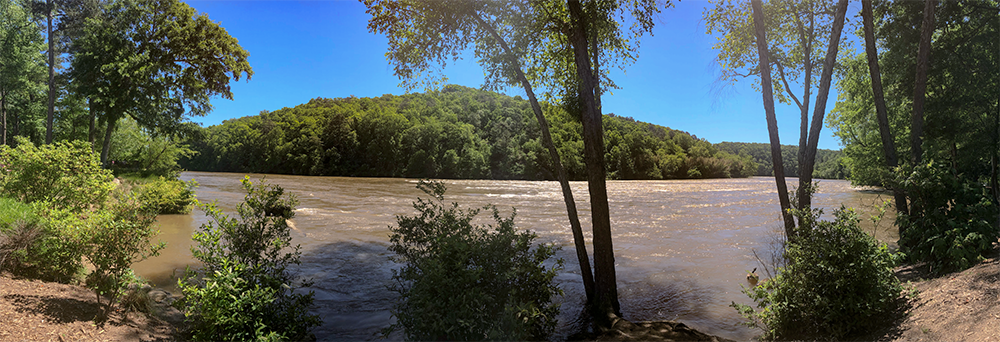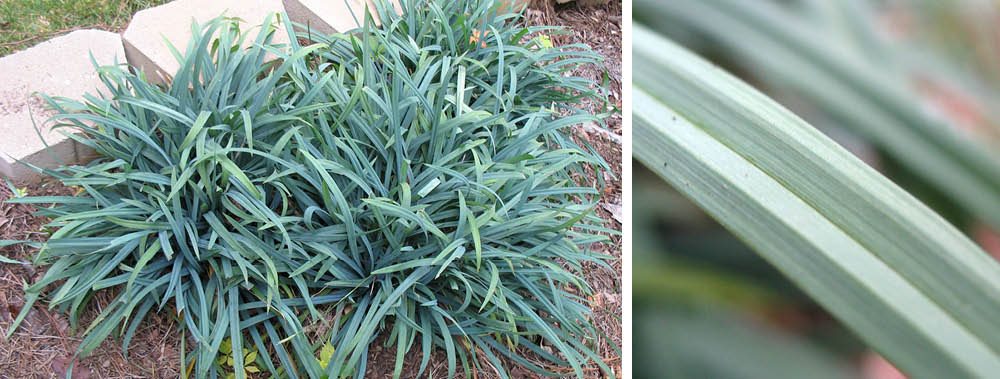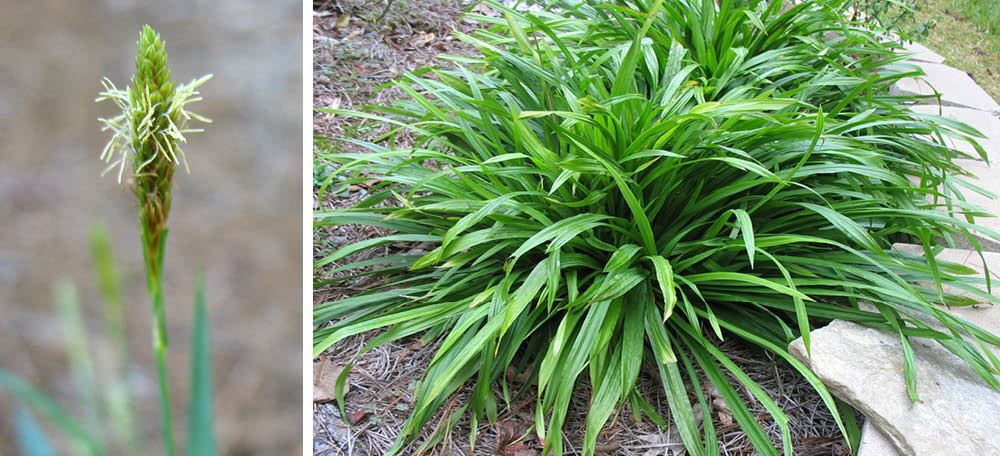May 2023 — Volume XXIX, Number 3 — Published by the Georgia Native Plant Society

A landscaped area on the banks of the Chattahoochee River includes native azalea, shrubby St. John's wort, sweetspire, river birch, and oakleaf hydrangea.
In This Issue ...
- Engaging with public policy students at Georgia Tech
- Spotlight on sedges
- Chapter News
Going Greener: Enhancing Georgia's Public Spaces with Native Plants
One of the strategic goals that we outlined in our Strategic Plan 2022-2025 was to increase our Advocacy efforts, particularly in the area of creating model ordinances and encouraging municipalities around the state to use more native plants in their communities. In July of 2022 we had the opportunity to become a client of a senior design course in the School of Public Policy at Georgia Tech. In becoming a client of this program, GNPS joins other groups like the Atlanta Regional Commission, The Nature Conservancy, Georgia Audubon, and Piedmont Park Conservancy.
The purpose of the program is to organize teams of undergraduate students to work on client-focused, policy-relevant projects that serve as their senior project. These two-semester projects are intended to provide a professional quality analysis to the organizations they serve.
Our request to the students was as follows: At GNPS, our build-a-better-landscape goal is to increase the availability of native plants in the nursery trade and their usage in public and private designed landscapes. While we can reach homeowners with this message, landscapes implemented and/or approved by municipalities comprise a lot of the opportunity for improvement.
GNPS Chair Ellen Honeycutt met with the students during the course of the study to review the progress and answer questions posed by the students. On April 21st, the students presented their final report and a number of GNPS Board members attended the presentation:
“This study aims to assist the Georgia Native Plant Society (GNPS) in developing an advocacy strategy for passing native plant legislation in Atlanta’s suburbs and other regions of the state by cataloging existing native plant policies and analyzing previous advocacy efforts.”
The final report includes a summary of their research and recommendations; three pages of referenced studies, articles, links to state and municipal ordinances and policies; and two model ordinances created specifically for this study by the students. All of these items will give GNPS members at the state and chapter level a jumpstart on working with their communities to influence native plant usage.
If you'd like to join our Advocacy Committee, please email board@gnps.org.
Plant Spotlight: Sedges (Carex)
Ellen Honeycutt

Creeping sedge (Carex laxiculmis) and a closeup of a leaf blade.
Grasses and grass-like plants are overlooked by many gardeners – they are plain and messy looking compared to clipped lawns and they don’t have showy flowers. Wait, they actually have flowers? Who knew?
While many folks might consider them all “grasses”, they aren't. For the most part, these grass-like plants fall into these 3 groups: sedges, rushes and grasses. In fact, you might have heard the familiar rhyme (which comes in several forms). The first one is my favorite:
“Sedges have edges; rushes are round; grasses are hollow right up from the ground.”
Another version of this poem is, "Sedges have edges, rushes are round, grasses have nodes and willows abound." Or “Sedges have edges, rushes are round, and grasses have joints.” All of these are meant to offer clues for identification.
So what does it mean that “sedges have edges”? Several sources describe the arrangement as having “triangular stems” – there are three edges as if the blade was V-shaped. One might consider that one edge is a ridge that runs down the center. The drawing of velvet sedge (Carex dasycarpa) by Jean C. Putnam (sourced from Georgia Biodiversity) has a leaf cross-section that illustrates the shape of the blade. Of course you can also identify it by ruling out the other two: if the leaves are not round, it’s not a rush. And if there are no joints on the stems and the leaf is not hollow, it’s not a grass.
Garden worthy features of Carex include being mostly evergreen, being shade tolerant, growing in a clump form, and being fairly deer resistant. Take note of what I said – deer resistant. Yep, I’m growing them right out in the open and they don’t eat them. They have eaten things right next to them, but they have not eaten the Carex.

Left: Carex laxiculmis flower. Right: Plantainleaf sedge (Carex plantaginea)
As you can see, Carex are handsome plants. There are hundreds of different species native to the United States, many native to the southeastern US. Across the different species, there are a range of different leaf colors, leaf widths and lengths, and growing conditions. Many are shade tolerant but others grow in the sun, especially morning sun. They are found in habitats that range from dry to wet and in between.
When it comes to design, Carex is one suggestion if you're looking for a native replacement for monkey grass (Liriope), a non-native plant often used for edging. You can see the resemblance. It’s also an important part of supporting wildlife. Its fruits are food for birds and small mammals, and Carex is #6 on the list of perennials that support native Lepidoptera (butterflies and moths) as a host plant, so the usage of it instead of a non-native plant is even more beneficial.
Carex also make a good options for implementing the Soft Landings approach (native plantings under keystone trees that support the life cycle of insects). As you consider plants for your landscape, add Carex to your list. They offer beautiful ways to increase the biodiversity in your garden.
This article was adapted from an earlier blog post on Using Georgia Native Plants.
Chapter News
Augusta's River Region Chapter
Augusta's River Region Chapter held its first rescue recently at the site of the new Grovetown hospital. There may be additional rescues; watch the rescue schedule for dates and follow the links to register.
Our May chapter meeting will be hosted for members at Betsy Ristroph's garden on Saturday, May 13th at 10 am. The address is 754 Oxford Rd in Augusta. Please bring a chair.
Coastal Plain Chapter
Okefenokee Swamp Park Habitat Restoration
The Coastal Plain Chapter will be the source for 18 different species of native plants to be used in the Okefenokee Swamp Park Habitat Restoration Day, with funds made possible by the National Fish and Wildlife Foundation’s Five Star and Urban Waters grant program.
The park is calling for volunteers on May 6, 2023, to restore a small area that was once filled with invasive and non-native plant species. Starting at 9:15 a.m., volunteers will plant native wildflowers, grasses, vines, shrubs and trees where bamboo, Chinese wisteria and other non-native vegetation once lived. A sampling of the species to be provided include sweet pepperbush (Clethra alnifolia), elderberry (Sambucus canadensis), stiff dogwood (Cornus foemina), scarlet rose hibiscus (Hibiscus coccineus) and lizard's tail (Saururus cernuus). Registration here is required to volunteer. Contact Katie Antczak at kantczak@okresa.org for more information.
CPC Grant to Library for Garden and Seed Bank
The Coastal Plain chapter has approved a grant for $100 to the St. Mary’s Library to start a pollinator garden and a seed library. The garden will consist of two 5’ x 12’ raised beds, with one bed for native plants and the other for vegetables. Patrons will be able to check out seeds, but must replace seeds before borrowing for a second time. Our chapter provided Monarda fistulosa, Salvia coccinea, and Asclepias incarnata as starter plants. The St. Mary’s Garden Club is providing seeds to get the seed library started, and the St. Mary’s Rotary Club and Lowe’s are contributing labor and supplies for the beds.
CPC Plant Sales
Our chapter’s plant sales continue with in-person and online sales. On May 5, 2023, the Coastal Plain Chapter will be selling plants at the Rosalynn Carter Butterfly Symposium in Plains, Ga., from 10 a.m. - 1:30 p.m. To order plants, check the plant list (https://cpcgnps.org/plant-sales/) that is updated after each sale. The minimum pre-sale (online) order is $35.00. Email cpcgnps@gmail.org to order plants.
Fringed Campion Chapter
The Fringed Campion Chapter was recognized on Earth Day, April 22, with the 2023 Educational Champion Award given by Earth Day Macon-Bibb for our leadership in establishing the Amerson River Park Native Plant Garden and Monarch Waystation.
The chapter has been awarded several grants recently. We have received one from the Macon Downtown Challenge for $5000 to go toward placing native plant gardens in containers around downtown. We have received one for $100 from the Community Foundation of Central Georgia and one for $400 from the Master Gardeners of Central Georgia to go towards the Amerson River Park garden. The garden has been approved by the GNPS State Restoration Committee as an educational garden and we have been granted $200 to go toward plants. We were also awarded a flat of Asclepias tuberosa plugs from MonarchWatch.org, bringing our milkweed total to 60 plants of four different species! The garden is also now registered on the Rosalynn Carter Butterfly Trail and as an official Monarch Waystation with MonarchWatch.org.
We have two upcoming events in May. The Roadsides, Wildflowers and Pollinator Insects Workshop will be held May 6th at Mercer University in Macon. Join us there to learn about GDOT's roadside wildflower program. On the morning of May 27th, we will have an invasive removal day at Amerson River Park in Macon. For more details and to sign up, check out our Facebook page at https://www.facebook.com/FringedCampionGNPS.
Intown Atlanta Chapter

The first certified habitat property visits included Jane Trentin's expansive wooded property on the Yellow River in Gwinnett County and Than Hunter's West Midtown urban property with an inviting wildflower meadow.
The Intown Atlanta Chapter has initiated a new GNPS program: Certified Habitat Property Visits. Designed to demystify the process of GNPS Habitat Certification, the program consists of a series of guided tours of previously certified habitats. Each visit is led by the homeowner, with additional facilitation provided by a member of the Intown Habitat Certification committee. These are not your typical garden tours — these visits are limited to about a dozen attendees and provide in-depth information not only about the native plants utilized by the homeowner, but also about meeting the various requirements of certification, including the adoption of at least four sustainable garden practices.
Seven property visits will be held in 2023, and two have already taken place. The chapter thanks Jane Trentin and Than Hunter for sharing their experiences with certification. Attendees have provided a lot of positive feedback, and two more visits have already been announced, filling up quickly with eager registrants.
Community Pods
The Intown Atlanta chapter has launched a new initiative called Community Pods to connect members who might be close neighbors. Members have started to get together and are planning their individual pod plans, such as simply sharing labor or knowledge, small neighborhood projects such as maybe a neighborhood garden plot, or attending GNPS events together. We're excited for members to get to know each other better and expand the grassroots reach of GNPS.
North Georgia Mountains Chapter
April has been a busy month for the North Georgia Mountains chapter. Our first invitation to man a table sharing information about native plants was to be held at Anna Ruby Falls, tied to a wildflower hike to the falls, scheduled for our usual meetings date — the second Saturday of the month. It got postponed to the following Saturday (due to torrential rains) but was very successful and appreciated by the park staff. They posted one of our Native Garden installation signs, although our role there was mostly providing identification labels for the plants that had been relocated after being dug up by feral pigs at their picnic area!
Our second such opportunity was the following Saturday, atop Brasstown Bald, again giving us the opportunity to inform many visitors about the importance of native plants. And on the 24th there was a gathering to start the design of a Connect to Protect Garden in the Satterfield preserve near Blairsville.
For May we will be back to the usual schedule, with the speaker at our May 13th meeting being Mickey Cummings, retired extension agent and author, on the Native Plants of North Georgia, focusing particularly on wildflowers, which are lovely given the season. The speaker at our June 10th meeting will be Jeff Barrett, our Plant Rescue organizer, to explain the process and inspire increased participation. Then in July (and August) we intend to have field trips in lieu of meetings, but the specific plans have not been laid out yet. Enjoy the rest of spring!
North Metro Chapter
May 13th at 10:00 a.m. — Heritage Park Workday
Habitat restoration work continues at Heritage Park in central Cobb County with tasks including invasive removal, native plantings, and garden maintenance.
May 20 at 10:00 a.m. — Native Plants and Pollinators
Ellen Honeycutt will be presenting about our native plants and how they benefit pollinators. Space is limited, register now!
May 27th at 10 a.m. — Old Rucker Farm Native Plant Habitat Workday
Join members from the chapter for a workday at the Old Rucker Farm Native Plant Habitat. Please sign up here.
|